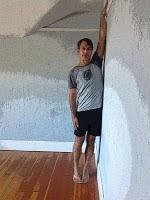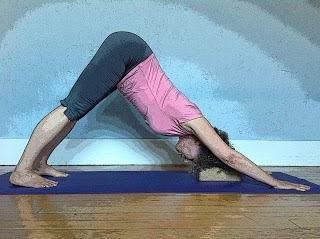 When I was doing research for my post on menopause and headaches (see Yoga for Menopause: Headaches), I was very surprised to learn that the most common complaint that Japanese women have during menopause is not headaches (which is what I previously thought) or hot flashes (the most common complaint in the US) but frozen shoulder. As many of you probably know by now, I experienced two bouts of frozen shoulder during perimenopause/menopause. Although I knew this condition was common among women my age, no one I consulted about the condition really tied it directly to menopause, although there was some speculation that it might be related to hormonal changes. That's because they all said no one really understands what causes this temporary (though very painful) problem. So it was very interesting for me to learn that in Japan it is considered a problem related to menopause. And because we've been focusing recently on menopause and I'm very, well, experienced, with this particular problem, I decided this would be a good time to write about it. (By the way, men also get frozen shoulders, and all the advice in this post will pertain to them as well.)
When I was doing research for my post on menopause and headaches (see Yoga for Menopause: Headaches), I was very surprised to learn that the most common complaint that Japanese women have during menopause is not headaches (which is what I previously thought) or hot flashes (the most common complaint in the US) but frozen shoulder. As many of you probably know by now, I experienced two bouts of frozen shoulder during perimenopause/menopause. Although I knew this condition was common among women my age, no one I consulted about the condition really tied it directly to menopause, although there was some speculation that it might be related to hormonal changes. That's because they all said no one really understands what causes this temporary (though very painful) problem. So it was very interesting for me to learn that in Japan it is considered a problem related to menopause. And because we've been focusing recently on menopause and I'm very, well, experienced, with this particular problem, I decided this would be a good time to write about it. (By the way, men also get frozen shoulders, and all the advice in this post will pertain to them as well.)So to start, what exactly is frozen shoulder? According to the Mayo Clinic web site:
"Frozen shoulder, also know as adhesive capsulitis, is a condition characterized by stiffness and pain in your shoulder joint. Signs and symptoms typically begin gradually, worsen over time and then resolve, usually within one or two years.
Treatment for frozen shoulder involves stretching exercises and, sometimes, the injection of corticosteroids and numbing medications into the joint capsule. In a small percentage of cases, surgery may be needed to loosen the joint capsule so it can move more freely.
Frozen shoulder typically develops slowly, and in three stages. Each of these stages can last a number of months:
Painful Stage: During this stage, pain occurs with any movement of your shoulder, and your shoulder's range of motion starts to become limited.
Frozen Stage: Pain may begin to diminish during this stage. However, your shoulder becomes stiffer, and your range of motion decreases notably.
Thawing Stage: During the thawing stage, the range of motion in your shoulder begins to improve."
I'd like to expand on this a bit. First of all, your range of motion, especially if you're a fairly flexible yoga practitioner like me, is drastically reduced. Basically, at the frozen stage you can barely move your arm, in any direction. Even lying on your back, with your arms resting directly on the floor can be painful because your arm needs to be in a completely neutral Tadasana position to be pain free. And the pain is really pretty bad! Sleeping is difficult unless you prop your arm up on a pillow so it doesn't hurt, and of course if you move your arm around in your sleep, pain may wake you up. Some ordinary household tasks are difficult or impossible because you can't raise your arm or carry heavy objects, like shopping bags. Eventually lack of use makes your arm weak, so when you're over the frozen shoulder, strengthening is important.
It's essential to have an expert diagnose you for frozen shoulder because other shoulder problems, such as a torn muscle, are treated very differently. But the tests for frozen shoulder are very simple and not invasive, because with a torn muscle, someone else can move your arm for you, but with a frozen shoulder, your arm just won't move at all. So your doctor or physical therapist, will simply move your arm for you in various directions.
Once you have a diagnosis, how can yoga help? Well, first yoga provides a lot of good shoulder stretching exercises, which are recommended by the Mayo Clinic. The sequence that Baxter and I developed for tight shoulders (see Featured Sequence: Opening Tight Shoulders) was partly influenced by the routine I developed for myself to stretch my frozen shoulder. Try poses 2 through 7 from this sequence. Of course, when your shoulder is frozen, your arm will not be able to be straight up the wall as in the photos, but even if you have to bend your elbow and creep the frozen arm just partly up the wall, that will still be a good stretch. This is one case where moving into the pain is actually beneficial rather than harmful. And I actually found that stretching left me feeling better afterward, so that helped motivate me to practice through the pain. And, hey, look at me now! (See Living Proof for my testimonial about the effectiveness of shoulder stretches.)
 To continue with your regular yoga practice, you'll need to modify your arm position in standing poses. For example, in Tree pose have your arms in namaste, in Warrior 2 pose have your hands on your hips, and Triangle and Extended Side angle poses, when your frozen arm is on top, just keep it tucked against your side or with your hand on your hip. In seated forward bends, you'll need to support your frozen arm, perhaps on a block, as you won't be able to reach for your feet. In restorative poses, be sure to place a folded blanket under your arms to support them so the frozen arm doesn't fall into a painful position. For poses you just can't do, like inversions or backbends, come up with an alternative. I did Standing Forward Bend and Widespread Standing Forward Bend with my head on a block instead of Headstand and Legs Up the Wall pose instead of Shoulderstand. You won't be able to do most backbends, so try practicing a passive, supported backbend of some kind to maintain mobility in your spine during this period. If you're in class, ask your teacher to help you find appropriate alternatives.
To continue with your regular yoga practice, you'll need to modify your arm position in standing poses. For example, in Tree pose have your arms in namaste, in Warrior 2 pose have your hands on your hips, and Triangle and Extended Side angle poses, when your frozen arm is on top, just keep it tucked against your side or with your hand on your hip. In seated forward bends, you'll need to support your frozen arm, perhaps on a block, as you won't be able to reach for your feet. In restorative poses, be sure to place a folded blanket under your arms to support them so the frozen arm doesn't fall into a painful position. For poses you just can't do, like inversions or backbends, come up with an alternative. I did Standing Forward Bend and Widespread Standing Forward Bend with my head on a block instead of Headstand and Legs Up the Wall pose instead of Shoulderstand. You won't be able to do most backbends, so try practicing a passive, supported backbend of some kind to maintain mobility in your spine during this period. If you're in class, ask your teacher to help you find appropriate alternatives. For the stress and pain associated with this condition, practice conscious relaxation in your favorite form (see The Relaxation Response and Yoga). When asana just seemed too hard for me because almost anything made my arm hurt, I experimented with a long version of yoga nidra.
Finally, after your shoulder is back to normal, your arm is going to be very weak from lack of use. Now is the time to do some arm strengthening poses! See Upper Body Strengthening the Easy Way and our featured upper body strengthening poses for ideas.
Of course, it is no fun going through this, but a frozen shoulder is a temporary condition. And with the help of yoga you can regain both flexibility and strength. Hey, I'm even back to doing arm balances!

